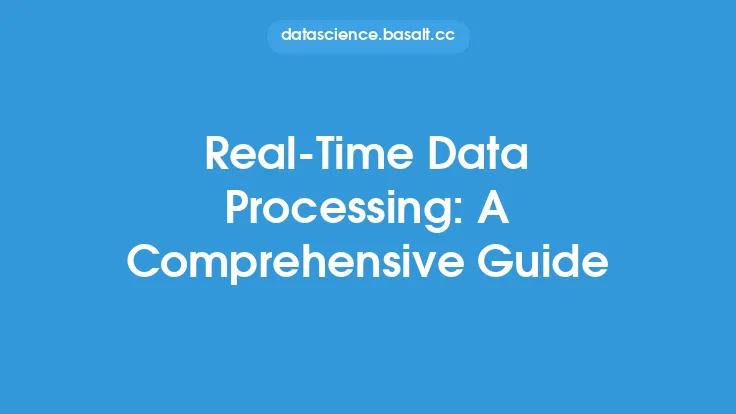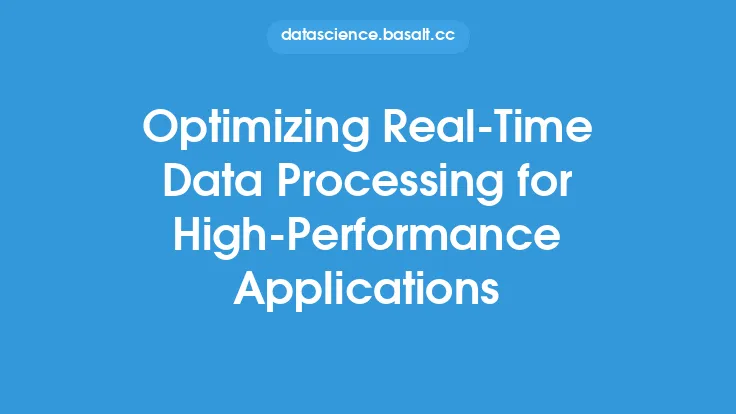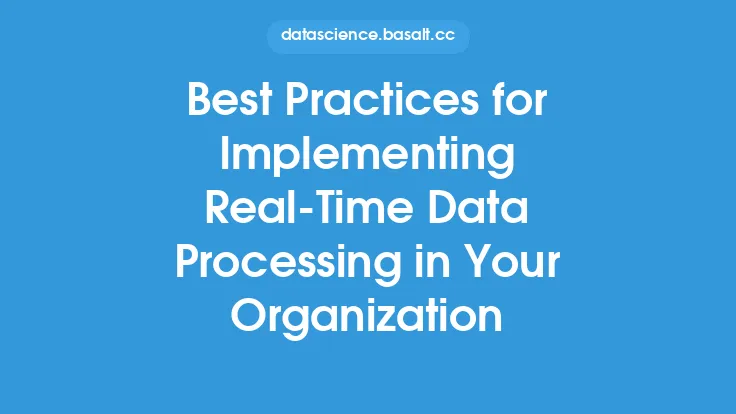Real-time data processing has become a crucial aspect of modern data engineering, enabling organizations to make informed decisions and respond to events as they occur. Two popular open-source technologies that have gained significant attention in this space are Apache Kafka and Apache Storm. In this article, we will delve into the world of real-time data processing with Apache Kafka and Apache Storm, exploring their architecture, features, and use cases.
Introduction to Apache Kafka
Apache Kafka is a distributed streaming platform that is designed to handle high-throughput and provides low-latency, fault-tolerant, and scalable data processing. It was originally developed by LinkedIn and is now maintained by the Apache Software Foundation. Kafka's architecture is based on a publish-subscribe model, where producers publish messages to topics, and consumers subscribe to these topics to consume the messages. This decoupling of producers and consumers allows for greater scalability and flexibility in data processing.
Kafka's key features include its ability to handle high-volume data streams, its fault-tolerant design, and its support for multiple data formats. It is also highly scalable, allowing it to handle large amounts of data and scale horizontally as needed. Kafka's use cases include log aggregation, metrics collection, and real-time analytics, among others.
Introduction to Apache Storm
Apache Storm is a distributed real-time computation system that is designed to process large amounts of data in real-time. It was originally developed by BackType and is now maintained by the Apache Software Foundation. Storm's architecture is based on a master-slave model, where the master node (Nimbus) distributes tasks to worker nodes (Supervisors), which execute the tasks and report back to the master node.
Storm's key features include its ability to process data in real-time, its support for multiple data sources and sinks, and its fault-tolerant design. It is also highly scalable, allowing it to handle large amounts of data and scale horizontally as needed. Storm's use cases include real-time analytics, machine learning, and data integration, among others.
Integrating Apache Kafka and Apache Storm
One of the most powerful aspects of Apache Kafka and Apache Storm is their ability to integrate with each other. Kafka can be used as a data source for Storm, allowing Storm to process the data in real-time. This integration enables organizations to build scalable and fault-tolerant real-time data processing pipelines.
The integration between Kafka and Storm is achieved through the use of a Kafka Spout, which is a Storm component that reads data from a Kafka topic and emits it to a Storm bolt for processing. The bolt can then perform various operations on the data, such as aggregation, filtering, or transformation, before emitting it to another bolt or a data sink.
Use Cases for Apache Kafka and Apache Storm
The combination of Apache Kafka and Apache Storm can be used in a variety of use cases, including:
- Real-time analytics: Kafka and Storm can be used to process large amounts of data in real-time, enabling organizations to gain insights and make informed decisions.
- Log aggregation: Kafka can be used to collect log data from multiple sources, and Storm can be used to process the data in real-time, enabling organizations to monitor and analyze their systems.
- Metrics collection: Kafka and Storm can be used to collect and process metrics data in real-time, enabling organizations to monitor and optimize their systems.
- Machine learning: Storm can be used to process data in real-time and train machine learning models, enabling organizations to make predictions and take action.
Architecture of a Real-Time Data Processing Pipeline
A real-time data processing pipeline using Apache Kafka and Apache Storm typically consists of the following components:
- Data sources: These are the systems or applications that generate the data to be processed. Examples include log files, metrics collectors, or social media platforms.
- Kafka producers: These are the components that publish the data to Kafka topics.
- Kafka topics: These are the buffers that store the data until it is consumed by a Kafka consumer.
- Kafka Spout: This is the Storm component that reads data from a Kafka topic and emits it to a Storm bolt for processing.
- Storm bolts: These are the components that process the data in real-time, performing operations such as aggregation, filtering, or transformation.
- Storm sinks: These are the components that store the processed data in a data sink, such as a database or a file system.
Best Practices for Implementing Apache Kafka and Apache Storm
When implementing Apache Kafka and Apache Storm, there are several best practices to keep in mind:
- Design for scalability: Kafka and Storm are designed to scale horizontally, so it's essential to design the system to take advantage of this scalability.
- Monitor and optimize: Monitor the system for performance issues and optimize as needed to ensure low-latency and high-throughput data processing.
- Use fault-tolerant design: Kafka and Storm are designed to be fault-tolerant, so it's essential to use this design to ensure that the system can recover from failures.
- Test thoroughly: Test the system thoroughly to ensure that it can handle the expected volume and velocity of data.
Conclusion
In conclusion, Apache Kafka and Apache Storm are two powerful technologies that can be used to build scalable and fault-tolerant real-time data processing pipelines. By integrating Kafka and Storm, organizations can process large amounts of data in real-time, enabling them to gain insights and make informed decisions. By following best practices and designing for scalability, organizations can ensure that their real-time data processing pipelines are efficient, effective, and reliable.





